The History Of FORD Taunus

Ford Taunus was a range of family cars sold by Ford in Germany and other countries. Models from 1970 onward were similar to the Ford Cortina in the United Kingdom.
The model line was named after the Taunus mountain range in Germany and was first made in 1939 and continued through several versions until 1982.
The original Taunus was a development of the Eifel and used the same 1172cc four cylinder engine but in a longer chassis and a streamlined body. It was the first German Ford to have hydraulic brakes. Due to the war, production was interrupted from 1942 to 1948. 74,128 were made including estate cars and light vans.
From 1952 to 1968 all German Fords were called the Taunus, using the model names 12M, 15M, 17M, 20M, and 26M. The "M" is said to stand for "Meisterstück", in English "Masterpiece". Taunus was also sometimes adopted as the brand-name in export markets, particularly where British and North American Fords were also available.
The 12, 15 and 17M models had a straight-4, later ones a V4 engine. The 20 and 26M models had a V6 engine. The 12, 15, 17 etc. refer to the engine displacement; 1200, 1500, 1700cc etc.
From 1962 to 1970, the smaller models 12M (P4) and 12M/ 15M (P6) had front wheel drive. All other models had rear wheel drive.
The following models were offered:
Smaller line: 12M, 15M
First generation 12M (G13) (1952-1959), 15M (1955–1959)
The first new German Ford after World War II. New pontoon body, similar in style to British Ford Zephyr. 12M maintains the old sidevalve engine of the Taunus, 15M uses a new and more powerful engine:
- 12M: 1172 cc, 38 hp (28 kW), 112km/ h (70mph)
- 15M: 1498 cc, 55 hp (40 kW), 128km/ h (80mph)
Body styles were two door sedan, two door station wagon and sedan delivery.
Second generation 12M (1959–1962)
Not a new car, but a rework of the 1952 model. All cars are called 12M, though both engines are continued (the car with the bigger engine is called "Taunus 12M 1.5 litre").
Body styles were the same as in the 1952 model.
Third generation 12M (P4) (1962–1966)
Same size, but a completely new car. New body, new V4 engine, front wheel drive. The first Ford car with front wheel drive (second is Ford Corcel, third is Ford Fiesta). Engines:
- 1.2 litre: 1183 cc, 40 hp (29 kW), 123km/ h (77mph)
- 1.5 litre: 1498 cc, 50, 55 or 65 hp (37, 40 or 48 kW), 135, 139 or 144km/ h (84, 87 or 90mph)
Body styles were two door sedan, four door sedan, two door coupé, two door station wagon and sedan delivery.
Fourth generation 12M (P6) (1966–1970), 15M (P6) (1966–1970)
New body, engines and platform are continued. Again, the car with the bigger engine is called 15M. Engines:
- 12M 1.2 litre: 1183 cc, 45 hp (33 kW), 125km/ h (78mph)
- 12M 1.3 litre: 1305 cc, 50 or 53 hp (37 or 39 kW), 130 or 134km/ h (81 or 84mph)
- 15M 1.5 litre: 1498 cc, 55 or 65 hp (40 or 47 kW), 136 or 145km/ h (85 or 90mph)
- 15M 1.7 litre: 1699 cc, 70 or 75 hp (51 or 55 kW), 153 or 158km/ h (95 or 98mph)
Body styles were unchanged from the P4.
In 1970, the P6 is replaced by the Taunus TC (see below).
Bigger line: 17M, 20M, 26M
First generation 17M (P2) (1957–1960)
Growing wealth in postwar Germany encourages Ford to offer a line of bigger and more expensive cars. Same size as British Consul Mk2, but a different car. Style similar to American 1956 Ford. The P2 uses a ohv engine with 1698 cc and 60 hp (44 kW). It can do 128km/ h (80mph).
Second generation 17M (P3) (1960–1964)
Completely new body in very modern style. Engine is now offered in three sizes:
- 1.5 litre: 1498 cc, 55 hp (40 kW), 136km/ h (85mph)
- 1.7 litre: 1698 cc, 60 or 65 hp (44 or 48 kW), 138 or 140km/ h (86 or 88mph)
- 1.8 litre: 1758 cc, 70 or 75 hp (51 or 55 kW), 148 or 154km/ h (92 or 96mph).
A very successful car.
Third generation 17M (P5) (1964–1967), 20M (P5) (1964–1967)
New body, new engines. 17M now gets a V4 engine:
- 1.5 litre: 1498 cc, 60 hp (44 kW), 140km/ h (88mph)
- 1.7 litre: 1699 cc, 65 or 70 hp (48 or 51 kW), 145 or 150km/ h (91 or 94mph).
New 20M gets a V6 engine with 2.0 litres (1998 cc) and 85 or 90 hp (63 or 66 kW) with a top speed of 158 or 161km/ h (99 or 101mph). Again, a good selling car.
Fourth generation 17M (P7) (1967–1968), 20M (P7) (1967–1968)
New body, engines and platform are continued. Very big, very boxy, very American. Not the car which European car buyers desire. A complete failure.
The engines of the 17M/ 20M P5 are continued with only one addition on the top end. It is the
- 20M 2.3 litre: 2293 cc, 108 hp (79 kW), 170km/ h (106mph).
Fifth generation 17M (P7.2) (1968–1971), 20M (P7.2) (1968–1971), 26M (1969–1971)
Shrinking sales of the P7 are forcing Ford to offer a restyled car only one year later. Ford is so ashamed by the failure of the last year's model that the new car is again called P7. Here, to avoid confusion, it is called P7.2, sometimes it is called P7b. 26M, introduced in 1969, is the top of the line version with the biggest engine (2.6 litres) and the most luxurious trim level. The engin program is enlarged; now there are two base engines (V4 and V6) in six displacement sizes and nine power stages:
- 17M 1.5 litre: 1498 cc, 60 hp (44 kW), 135km/ h (85mph)
- 17M 1.7 litre: 1699 cc, 65 or 75 hp (48 or 55 kW), 140 or 150km/ h (88 or 94mph)
- 17M 1.8 litre: 1812 cc, 82 hp (60 kW), 153km/ h (96mph)
- 20M 2.0 litre: 1998 cc, 85 or 90 hp (63 or 66 kW), 155 or 160km/ h (97 or 100mph)
- 20M 2.3 litre: 2293 cc, 108 or 125 hp (79 or 92 kW), 170 or 180km/ h (106 or 112mph)
- 20M 2.6 litre, 26M: 2550 cc, 125 hp (92 kW), 180km/ h (112mph)
Please note: The 17M 1.8 litre uses a V6 engine. The 2.6 litre engine is optional on 20M, but standard on 26M.
This is the last specifically German Ford. In early 1972, it is replaced by the new Consul and Granada.
In 1970 a new Taunus, the Taunus TC, was introduced, as a two- or four-door sedan, station wagon (or Turnier) and coupé. It was very similar to the British Ford Cortina Mk III but without the "coke bottle" belt line. Also, the Taunus was available as a coupe, a bodystyle that the Cortina was never made in.
Both cars were developed under the auspices of Ford of Europe, and most major components including key parts of the bodyshell were identical (TC means "Taunus Cortina", to show the similarity of the cars). From 1976 Taunus and Cortina models were identical in all but name, 'Taunus' being the name used in left hand drive (LHD) markets, and 'Cortina' in right hand drive ones, although the Cortina name was used in LHD South Korea and Taiwan. The Mk III was also sold in Scandinavia, alongside the Taunus.
The Ford Taunus TC series was conceived in the late 1960s to be a "world car" alongside its technical sibling the Cortina Mk III, with construction and design work taking place on both sides of the Atlantic. As with the design of the first generation, it was done under the supervision of Semon "Bunkie" Knudsen, of former General Motors fame. The car is often nicknamed "Barock 2" (pointing back to the Taunus P2 series of the late 1950s, commonly known as the "Barock-Taunus") or "The Knudsen Nose" by its German owners because of the pointy hood scoop that, as the legend has it, was put there on direct order from Knudsen. Otherwise the major design work is rumoured to have been done by German car designer Luigi Colani, who also did design concepts for BMW's motorcycle division in the late 1970s.
As from the 1976 model year the Taunus and Cortina were essentially the same cars. The Taunus TC along with the Cortina Mk III and their successors have been produced in slightly updated forms in Europe, Argentina and Asia (some Cortinas were built under license by Korean automaker Hyundai) with the last Turkish Otosan-Taunus leaving the factory in the mid-nineties. However the major components remained basically the same through the entire production run only receiving minor body changes with the biggest re-engineering in the 1979 model year, which involved a facelift (identical to the Ford Cortina Mk5 update).
The Taunus/ Cortina was finally replaced by the Sierra in late 1982. The Sierra carried over the Cortina/ Taunus OHC Pinto Engines and RWD configuration but was otherwise an all new car with independent suspension all round.
The Taunus and Cortina models are very easy to service and share a lot of mechanical components with the other European Ford cars of the period (excluding the Ford Fiesta), making them extremely easy to fix, although they are now a rare sight in even the markets where they were most popular. For example, the British Cortinas of this generation sold more than 1,000,000 units, but little more than 2,000 were in circulation by 2006.
In 1982 production of the Taunus ceased in Europe; it was replaced by the Ford Sierra. Production continued in Argentina until 1984, where a coupé version (effectively a two-door saloon) remained in the line-up right until the end (while in Germany the coupé was dropped after the 1975 facelift), and at Otosan in Turkey, where a restyled version of the last model continued in production until 1994.
From Wikipedia, the free encyclopedia
More About FORD Taunus



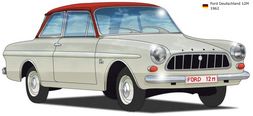
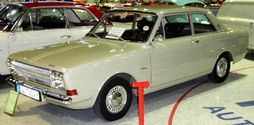
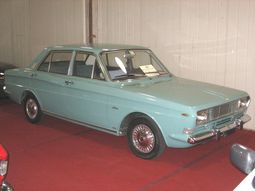
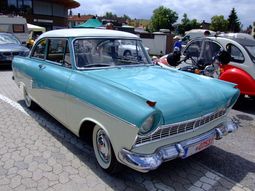
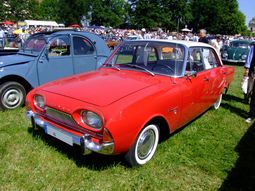

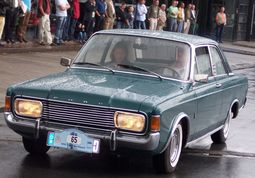

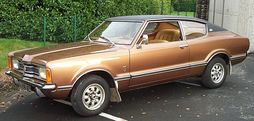

|